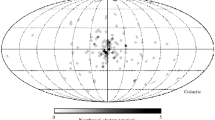Abstract
Changes of the orbit of a star passing through a homogeneous spherical cluster have been estimated. Before entering the cluster the star is supposed to move in a Keplerian parabolic orbit. When passing through the cluster the star is subject both to the attraction of the smoothed-out distribution of matter in the cluster and to dynamical friction. Due to dynamical friction the energy of the star becomes negative which leads to the elliptic-type motion of the star after leaving the cluster and to capturing the star by the cluster.
The formulae for the changes of the star orbit in the cluster are given. Numerical estimation shows that open clusters transform star orbits more noticeably than do globular clusters.
Similar content being viewed by others
References
Baranov, A. S. and Batrakov, Yu. V.: 1974a,Astron. Zh. 51, 310.
Baranov, A. S. and Batrakov, Yu. V.: 1974b, in Y. Kozai (ed.), ‘The Stability of the Solar System and of Small Stellar Systems’,IAU Symp. 62, 265.
Chandrasekhar, S.: 1943,Astrophys. J. 97, 255 (Parts I, II);98, 54 (Part III).
Subbotin, M. F.: 1968,Vvedenie v Teoreticheskuyu Astronomiyu, Moscow.
Author information
Authors and Affiliations
Rights and permissions
About this article
Cite this article
Baranov, A.S. Capture of stars by rotating homogeneous spherical clusters. Celestial Mechanics 11, 517–528 (1975). https://doi.org/10.1007/BF01650287
Received:
Issue Date:
DOI: https://doi.org/10.1007/BF01650287



